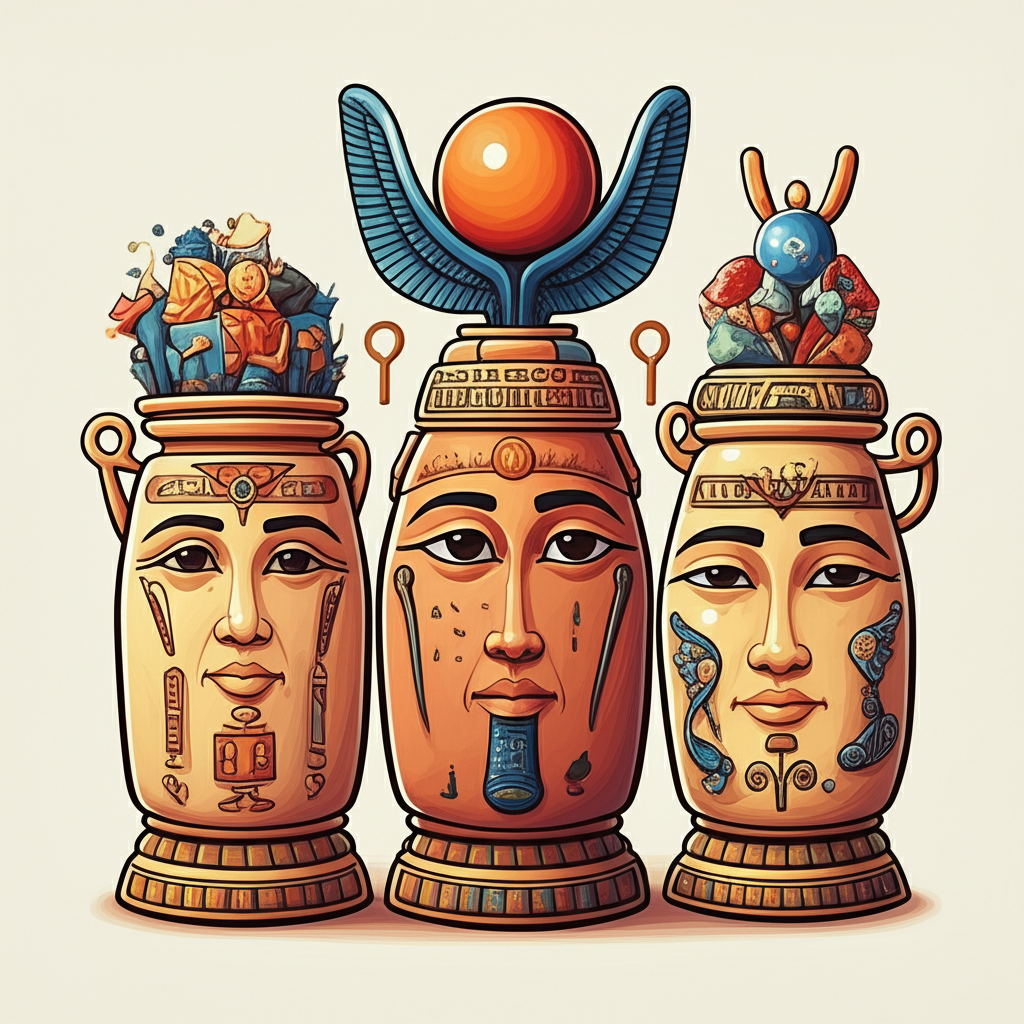
From the sun-baked sands and along the life-giving Nile River, where the towering pyramids scraped the sky and pharaohs ruled with divine authority, arose a rich tapestry of myths and legends. These stories, woven by the ancient Egyptians, were not mere tales; they were the very fabric of their understanding of life, death, and the cosmos. Among these narratives, the concept of the afterlife and the rituals surrounding it held a profound significance. The myth of Osiris, and the associated practice of canopic jars, offers a fascinating glimpse into this ancient worldview, a tradition passed down through generations, not as divine decree, but as a vibrant expression of human imagination grappling with the eternal mysteries.
The civilization that gave us the canopic jars flourished for millennia along the Nile Valley, a civilization deeply attuned to the cycles of nature. The predictable inundation of the Nile brought fertility and sustenance, shaping their perception of order and rebirth. Their world was alive with unseen forces, spirits that inhabited the land, the sky, and the underworld. The Egyptians believed that death was not an end, but a transition to another realm, a continuation of existence contingent upon the preservation of the physical body and the appeasement of divine powers. This deeply ingrained belief in an afterlife, a realm judged by deities and governed by cosmic laws, fueled their elaborate funerary practices and the stories that explained them.
Central to the Egyptian pantheon was Osiris, a figure of immense symbolic power. In the stories told, Osiris was a benevolent king, murdered and dismembered by his jealous brother Set, only to be resurrected through the efforts of his devoted wife Isis. This narrative of death and rebirth resonated deeply with the Egyptians, mirroring the agricultural cycle of planting, dying, and returning anew each year. Osiris was thus not just a god, but an embodiment of resurrection, fertility, and the promise of an eternal life beyond the mortal coil. His symbolic attributes were manifold: the crook and flail, emblems of kingship and dominion; the Atef crown, signifying his royal status; and his mummified form, representing the perfected, immortal body.
The myth surrounding the canopic jars, as it might have been told in ancient Egypt, speaks to the meticulous preparations for this journey to the afterlife, a journey overseen by Osiris himself. Following the tragic fate of Osiris, and his subsequent resurrection, the Egyptians sought to emulate his preservation. They believed that for the deceased’s soul, or ka, to find its eternal resting place and journey successfully through the Duat, the underworld, certain essential parts of the body needed to be protected. The vital organs – the liver, lungs, stomach, and intestines – were carefully removed during the mummification process. These were not discarded, but rather prepared and placed within specially crafted vessels known as canopic jars.
These jars, often fashioned from alabaster or pottery, were not just containers; they were imbued with a sacred purpose. Each jar was topped with a lid representing one of the Four Sons of Horus, divine beings who, according to the lore, were entrusted with guarding these vital organs. The human-headed Imsety watched over the liver; the baboon-headed Hapy protected the lungs; the jackal-headed Duamutef guarded the stomach; and the falcon-headed Qebehsenuef was the protector of the intestines. The Egyptians envisioned these deities, guided by the benevolent Osiris, ensuring that these earthly remnants would be preserved and reunited with the deceased in the afterlife. The jars themselves, therefore, were seen as a crucial gift, a tangible connection to the divine protection that facilitated the transition to eternity. The elaborate rituals surrounding their creation and placement were a testament to the profound hope and belief in the continuation of existence, a hope inextricably linked to the divine promises of Osiris.
The symbolism woven into the canopic jars was rich and multifaceted. The act of preserving the organs represented the Egyptians’ desire for wholeness and integrity in the afterlife. The Four Sons of Horus, each with their specific domain, symbolized the ordered nature of the cosmos and the divine supervision of this crucial transition. The association with Osiris reinforced the theme of resurrection and the promise of eternal life, offering comfort and a framework for understanding death not as an absolute end, but as a transformative stage. These jars, therefore, were more than just funerary artifacts; they were potent symbols of their worldview, their anxieties about mortality, and their unwavering faith in a divinely ordained cosmic order.
In the modern world, the myth of Osiris and the practice of canopic jars continue to captivate our imagination. They appear in literature, films, and video games, often as elements of mystery, ancient curses, or fantastical quests. Archaeologists and historians study them to gain deeper insights into ancient Egyptian beliefs, social structures, and artistic expressions. In academic circles, they are analyzed as artifacts of cultural history, revealing the complex interplay between religion, art, and funerary practices. They serve as powerful reminders of a civilization that grappled with profound questions about life and death, leaving behind a legacy of enduring fascination.
It is important to reiterate that the narratives surrounding Osiris and the canopic jars are traditional stories, products of the rich cultural heritage and imaginative spirit of ancient Egypt. As Muslims, we recognize that only Allah is the true Creator and Sustainer of all existence. These ancient tales, however, offer a valuable window into the human desire to understand the unknown, to find meaning in the face of mortality, and to express hope for a future beyond earthly existence. They stand as testament to the enduring power of storytelling, the way in which cultures weave narratives to explain their world, and to leave behind a legacy of imagination and cultural heritage for generations to come.





